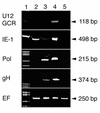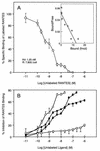Human herpesvirus 6 open reading frame U12 encodes a functional beta-chemokine receptor
- PMID: 9621074
- PMCID: PMC110416
- DOI: 10.1128/JVI.72.7.6104-6112.1998
Human herpesvirus 6 open reading frame U12 encodes a functional beta-chemokine receptor
Abstract
Human herpesvirus 6 (HHV- 6), which belongs to the betaherpesvirus subfamily and infects mainly T cells in vitro, causes acute and latent infections. HHV- 6 contains two genes (U12 and U51) that encode putative homologs of cellular G-protein-coupled receptors (GCR), while three other betaherpesviruses, human cytomegalovirus, murine cytomegalovirus, and human herpesvirus 7, have three, one, and two GCR-homologous genes, respectively. The U12 gene is expressed late in infection from a spliced mRNA. The U12 gene was cloned, and the protein was expressed in cells and analyzed for its biological characteristics. U12 functionally encoded a calcium-mobilizing receptor for beta-chemokines such as regulated upon activation, normal T expressed and secreted (RANTES), macrophage inflammatory proteins 1alpha and 1beta (MIP-1alpha and MIP-1beta) and monocyte chemoattractant protein 1 but not for the alpha-chemokine interleukin-8, suggesting that the chemokine selectivity of the U12 product was distinct from that of the known mammalian chemokine receptors. These findings suggested that the product of U12 may play an important role in the pathogenesis of HHV- 6 through transmembrane signaling by binding with beta-chemokines.
Figures








Similar articles
-
Human herpesvirus 7 open reading frame U12 encodes a functional beta-chemokine receptor.J Virol. 2003 Jul;77(14):8108-15. doi: 10.1128/jvi.77.14.8108-8115.2003. J Virol. 2003. PMID: 12829849 Free PMC article.
-
Human herpesvirus 7 open reading frames U12 and U51 encode functional beta-chemokine receptors.J Virol. 2005 Jun;79(11):7068-76. doi: 10.1128/JVI.79.11.7068-7076.2005. J Virol. 2005. PMID: 15890946 Free PMC article.
-
RANTES binding and down-regulation by a novel human herpesvirus-6 beta chemokine receptor.J Immunol. 2000 Mar 1;164(5):2396-404. doi: 10.4049/jimmunol.164.5.2396. J Immunol. 2000. PMID: 10679075
-
Viral G Protein-Coupled Receptors Encoded by β- and γ-Herpesviruses.Annu Rev Virol. 2022 Sep 29;9(1):329-351. doi: 10.1146/annurev-virology-100220-113942. Epub 2022 Jun 7. Annu Rev Virol. 2022. PMID: 35671566 Free PMC article. Review.
-
Structure and function of the CC chemokine receptor (CCR) 8.Forum (Genova). 1999 Oct-Dec;9(4):315-24. Forum (Genova). 1999. PMID: 10611408 Review.
Cited by
-
The human herpesvirus 6 G protein-coupled receptor homolog U51 positively regulates virus replication and enhances cell-cell fusion in vitro.J Virol. 2005 Sep;79(18):11914-24. doi: 10.1128/JVI.79.18.11914-11924.2005. J Virol. 2005. PMID: 16140767 Free PMC article.
-
Age-Related Macular Degeneration: A Connection between Human Herpes Virus-6A-Induced CD46 Downregulation and Complement Activation?Front Immunol. 2017 Oct 17;8:1314. doi: 10.3389/fimmu.2017.01314. eCollection 2017. Front Immunol. 2017. PMID: 29093709 Free PMC article.
-
Viral gene expression patterns in human herpesvirus 6B-infected T cells.J Virol. 2002 Aug;76(15):7578-86. doi: 10.1128/jvi.76.15.7578-7586.2002. J Virol. 2002. PMID: 12097571 Free PMC article.
-
Viral G protein-coupled receptor and Kaposi's sarcoma: a model of paracrine neoplasia?J Exp Med. 2000 Feb 7;191(3):417-22. doi: 10.1084/jem.191.3.417. J Exp Med. 2000. PMID: 10662787 Free PMC article. No abstract available.
-
Emerging roles of cytomegalovirus-encoded G protein-coupled receptors during lytic and latent infection.Med Microbiol Immunol. 2019 Aug;208(3-4):447-456. doi: 10.1007/s00430-019-00595-9. Epub 2019 Mar 21. Med Microbiol Immunol. 2019. PMID: 30900091 Review.
References
-
- Ablashi D V, Balachandran N, Josephs S F, Hung C L, Krueger G R F, Kramarsky B, Salahuddin S Z, Gallo R C. Genomic polymorphism, growth properties, and immunologic variations in human herpesvirus-6 isolates. Virology. 1991;184:545–552. - PubMed
-
- Ahuja S K, Murphy P M. Molecular piracy of mammarian interleukin-8 receptor type B by herpesvirus saimiri. J Biol Chem. 1993;268:20691–20694. - PubMed
-
- Arvanitakis L, Geras-Raake E, Varma A, Gershengorn M C, Cerarman E. Human herpesvirus KSHV encodes a constitutively active G-protein-coupled receptor linked to cell proliferation. Nature. 1997;358:347–350. - PubMed
-
- Aubin J-T, Agut H, Collandre H, Yamanishi K, Chandran B, Montagnier L, Huraux J-M. Antigenic and genetic differentiation of the two putative types of human herpesvirus 6. J Virol Methods. 1993;41:223–234. - PubMed
Publication types
MeSH terms
Substances
LinkOut - more resources
Full Text Sources
Other Literature Sources
Research Materials

